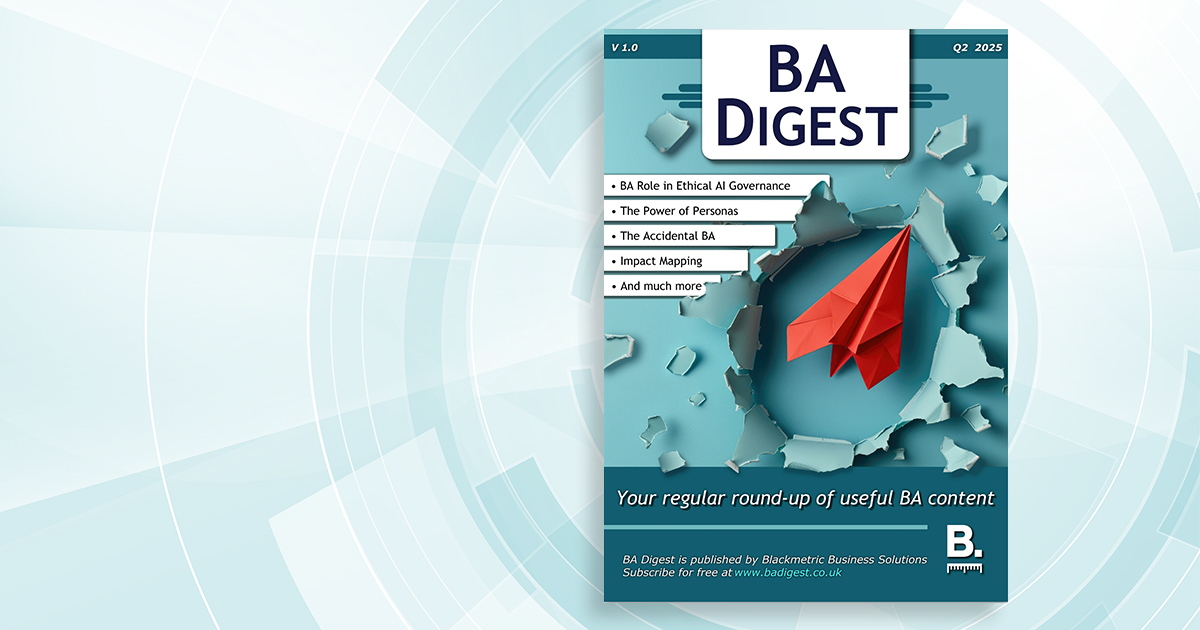Ethical AI Governance, Prototyping, and Requirements Architecture
3 Key Takeaways From BA Digest (Q2 Edition)
Disclaimer: The views and opinions expressed in this article are those of the author and may not reflect the perspectives of IIBA.
The Q2 edition of BA Digest was recently released, which contains seventeen diverse articles. If you’re short of time, here’s a summary of three.
1. Ethical AI Governance
In “Business Analyst Role in AI Governance with Ethical AI Training Model,” Afifah Hanun highlights the crucial role that business analysis professionals play in AI governance by bridging the gap between technical teams and business goals. In doing so, they help to define ethical guidelines, identify biases, and balance innovation with responsibility. They can work with different stakeholders to create AI policies that ensure fairness, transparency, and accountability, which are crucial for successfully implementing AI systems.
Afifah suggests that one of the key responsibilities of business analysis professionals is bias identification and mitigation. This offers a unique perspective, addressing potential biases in training data and making AI systems more inclusive and effective for diverse populations. By explaining the effects of bias in simple terms, practitioners foster trust and transparency among stakeholders, which is essential for user confidence in AI technologies.
As businesses adopt AI, the role of business analysis professionals will evolve, making their ability to address ethical challenges essential. Practitioners are essential for ethics and accountability because their contributions ensure AI systems align with organizational goals and societal values.
2. Prototyping and Psychological Safety
In “Prototyping with Confidence: Iterations and Psychological Safety,” Dominik Lischer discusses the evolution of prototyping, emphasizing its iterative nature and the importance of feedback in product development.
Historically, prototyping involved physical models, but technological advancements such as CAD and 3D printing have transformed the process. Agile frameworks such as Scrum encourage iterative and incremental development, allowing teams to present prototypes to users for regular feedback. This helps identify design flaws and align products with customer needs.
Despite the benefits of prototyping, challenges such as communication breakdowns and the fear of failure can hinder progress. Dominik highlights the necessity of clear communication and managing expectations within teams. Team members should embrace trial and error and handle feedback constructively, creating an environment where all contributions are valued, even imperfect ones.
A key factor for successful iterative projects is psychological safety. In a psychologically safe environment, team members feel comfortable sharing ideas, admitting mistakes, and questioning the status quo without fear of repercussions. Managers are key in creating a supportive environment that encourages open communication and active listening, which boosts project success.
3. Requirements Architecture
In “The Power of Organisation: Maximising Project Outcomes through Requirements,” Olena Myslitska discusses the often-overlooked concept of "requirements architecture." She emphasizes its importance in organizing business analysis information and requirements artifacts. A well-structured requirements architecture helps teams focus on crucial elements, enhancing communication and saving time during project development.
Olena outlines various categories of requirements artifacts, such as planning documents, general artifacts, product vision, and requirements. She suggests that teams adopt a logical organization of requirements artifacts that maintains simplicity. After all, requirements architecture allows requirements traceability to take place!
There are many tools to support business analysis professionals in maintaining a requirements architecture. Olena notes that tools like Jira and Azure DevOps, while helpful, mainly serve developers and project managers. They restrict business analysis professionals’ ability to manage requirements effectively. She instead advocates for using more suitable tools, such as Confluence or Notion, which better support the holistic requirements architecture necessary for effective business analysis.
The Importance of Staying Current
The business analysis role is ever-evolving, and these articles show the importance of continuing to grow as a practitioner and learn from others in the community. Be sure to check out IIBA’s KnowledgeHub for more information and inspiration!
For more thought-provoking articles like the ones mentioned above, download your copy of BA Digest—a free, open-access, quarterly magazine published by Blackmetric that focuses on all things business analysis.
About the Author

Adrian Reed is a true advocate of the analysis profession. He acts as Principal Consultant at Blackmetric Business Solutions, where he provides business analysis consultancy and training solutions to a range of clients in varying industries. He is editor-in-chief of the quarterly open-access magazine BA Digest, and he speaks internationally on topics relating to business analysis and business change. Adrian wrote the 2016 book Be a Great Problem Solver… Now and the 2018 book Business Analyst.



